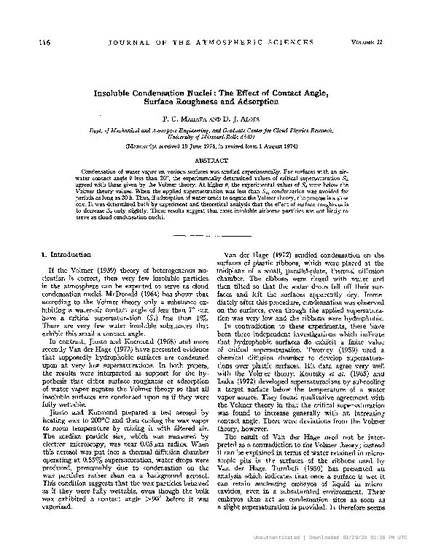
Article
INSOLUBLE CONDENSATION NUCLEI: The EFFECT of CONTACT ANGLE, SURFACE ROUGHNESS and ADSORPTION.
Journal of the Atmospheric Sciences
Abstract
Condensation of Water Vapor on Various Surfaces Was Studied Experimentally. for Surfaces with an Air-Water Contact Angle Theta Less Than 20 Degree, the Experimentally Determined Values of Critical Supersaturation S//c Agreed with Those Given by the Volmer Theory. at Higher Theta, the Experimental Values of S//c Were Below the Volmer Theory Values. When the Applied Supersaturation Was Less Than S//c, Condensation Was Avoided for Periods as Long as 20 H. It Was Determined Both by Experiment and Theoretical Analysis that the Effect of Surface Roughness is to Decrease S//c Only Slightly. These Results Suggest that Most Insoluble Airborne Particles Are Not Likely to Serve as Cloud Condensation Nuclei.
Department(s)
Mechanical and Aerospace Engineering
Document Type
Article - Journal
Document Version
Final Version
File Type
text
Language(s)
English
Rights
© 2023 American Meteorological Society, All rights reserved.
Publication Date
1-1-1975
Publication Date
01 Jan 1975
Disciplines
Citation Information
P. C. Mahata and Darryl J. Alofs. "INSOLUBLE CONDENSATION NUCLEI: The EFFECT of CONTACT ANGLE, SURFACE ROUGHNESS and ADSORPTION." Journal of the Atmospheric Sciences Vol. 32 Iss. 1 (1975) p. 116 - 122 ISSN: 0022-4928 Available at: http://works.bepress.com/darryl-alofs/47/